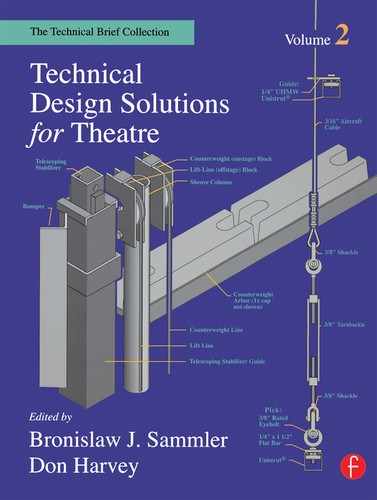Robert Coleman |
Spot-Welding Scrim with Sobo® |
While working as TD for the Opera Festival of New Jersey, I hung the company’s black scrim late in load-in to prevent accidental damage, only to find a series of half-dollar sized holes like the one shown in Figure 1 at the right. Time and money precluded scrim replacement, and although we made a determined attempt, no one on the crew proved capable of professional-quality reweaving. We also vainly tried two other approaches — sewing the holes shut, and stitching patches over them. All three techniques were tediously slow, and our repairs, while better-looking than the holes, were not satisfactory. Still, lacking better alternatives, we persevered in our efforts.
One afternoon, Stephan Olson, one of our designers, noticed what we were doing and told me about a “fur” an old Broadway hand had shown him: rather than sew a patch in, Olson suggested, we could “spot-weld” it with Sobom glue. I was a bit skeptical, but decided to try this method, which proved easy, fast, and effective.

FIGURE 1: A SUCCESSFUL SPOT-WELD
MATERIALS AND PROCESS
Spot-welding scrim with Sobo® is simplicity itself. For most repairs all you need is glue, some scrim scraps, a pair of scissors, and one or more embroidery hoops. Some repairs will require a helper and one or more small scraps of clear acrylic sheeting.
The process has only four steps:
tension the damaged area
trim away any untensioned flaps
cut a patch and lay it in place
spot-weld the patch in place with Sobo®
The notes and photos on the following pages provide the necessary details.

FIGURE 2: A CANDIDATE FOR SPOT-WKLDING
STEPS 1 AND 2: TENSION AND TRIM THE DAMAGED AREA
The damaged area must first be tensioned. An appropriate amount of tension can be provided by the weight of the scrim’s bottom pipe if the piece is hanging and the holes are within easy reach, or by the use of an embroidery hoop if the scrim is down. For readers unfamiliar with the device, an embroidery hoop is a set of two wooden or plastic circles, one of which nests inside the other, trapping and stretching fabric between them. Shown in use in Figures 3, 4, and 5, they range from 3″ to 12″ and more in diameter, are very inexpensive, and are available at any fabric shop. With the damaged area tensioned, cut away any loose flaps, trimming the tear into a rough circle.


FIGURE 4: GLUING BY THE NUMBERS

FIGURE 5: A FINISHED PATCH
STEPS 3 AND 4: PREP AND SPOT-WELD THE PATCH
Trim a patch from scrap scrim. Size the patch to fit inside the hole without overlapping the threads around it. Align the weave of the patch with that of the weave of the scrim as shown in Figure 3, and “spot-weld” the patch in with Soboa as in Figure 4, applying small dots of the glue at positions corresponding to the numbers on a clock. Do not stretch the patch into position. Sobo® spot-welding works because while the scrim is under tension, the patch is not: all the patch has to do is fill the hole. Because there’s no tension on the patch, a few small dots of glue are sufficient to hold it in place. The fewer dots you use, the fewer spots there will be to reflect stage light. Once the glue has dried, the repair is complete and the goods can be put back into service.
NOTES
Sobo® seems the best glue for this purpose. It “tacks” quickly, remains reasonably flexible when dry, and isn’t very shiny. We tried some other glues — including some designed for fabric — but the results were not as good. All of them became more brittle, and some of them were too shiny.
There is certainly room for experimentation, but we found that tears trimmed to a circular shape resisted the tension well, and round patches are easy to make. Obviously, if you used embroidery hoops as tensioners, the trimmed tears would have to be significantly smaller than the hoops. Other limits seem likely: I doubt that long tears, for instance, could be repaired with this approach. In any case, long tears are fairly easy to sew.
If you’re repairing a scrim that’s already in the air, you’ll need a helper working behind the goods. The helper must first push the “back” half of the embroidery hoop toward you to help you capture and tension the fabric, and then hold a “backing plate” behind the damaged area so that the scrim doesn’t drift away from you while you’re working.
If that backing plate is transparent, your helper will be able to see what you’re doing; if it’s nonporous, it won’t get glued to the goods. Glass might do, but a scrap of clear acrylic sheeting probably works best as a backing plate.

FIGURE 6: “BACKING” A REPAIR WITH CLEAR ACRYLIC SHEETING
FINAL COMMENTS
Spot-welding scrim with Sobo® is a handy technique in situations where time or money is short. Its results are far less likely to be visible from the house than are the repairs other techniques produce. Conveniently, it can be done whether the scrim is in the air or on the ground. Last, though it is neither as permanent nor as elegant as professional reweaving, “’tis enough, ’twill serve.″
